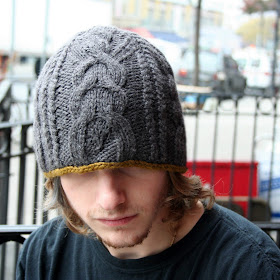Every time a plastic snow-flake light blings, a realtor get's his or her wings. The
Flatbush Development Corporation had already hung the Holiday illuminations to remind us that a
Brooklyn Renaissance is happening. It's as if Unitarian elves snuck in and did their deed while I was watching the news. I wondered what was hanging over the streets of Redhook. I paused at the corner to light my cigarette when someone waved at me and crossed the avenue. “Pappi, how you doin’?” It was no one that I knew. “Look, I just got out of Federal, and I just need some money.” He held out his leathery hand, I shook my head no and gave him a cigarette that he put it in his pocket. “You got any money, pappi…”

Meanwhile down the street a renaissance has already been happening — Wednesday night knitting at Maha’s Café. Tawni was already there, I introduced myself and we both got something to eat. Eliza showed up, but said she had to leave early, then walked in Jane, Emily and Archie. Tawni works in the food service industry, Eliza designs for the theatre. Emily is an industrial designer.
Archie finished one of those beautiful
"Koolhaas" BrooklynTweed hats and then started the next one, he teaches Trig. Emily finished her baby hats “but anther friend is having a baby.” She’s working on her first pair of mittens. Eliza was working on a very petite plum colored cardigan with a delicate ruffled edge. I was working on a swatch and my chicken dinner. I think Jane is in school, but she teaches knitting at a swank UWS yarn shoppe. She made the heather pink sweater that she was wearing. She lives in the new China Town near Bayridge.

The conversation revolved around different yarns, new patterns, classic patterns, work, the weather, family, and the Holidays. Tawni started knitting about a year ago but gave up. She felt a group would help to inspire her. I showed her a better cast-on method (the long-tail) and then guided her through the basics to make a small garter stitch scarf. But over the course of the evening it grew from a square to a triangle. Emily took a look and pointed out that Tawni was knitting the last loops on each end twice. Then Jane showed her where a few stitches were dropped, then I pointed out that some of the stitches were taken from the row below, then Archie reached over to correct the dropped stitch on the end. Jane asked her if she wanted to learn how to purl. I don’t think this is what is meant by word “knitting group” — Tawni was a real trouper. She said she'd eventually wanted to learn style of holding that Jane and I were using: Continental.
Making Our "Standards" More StandardSome knitting terms are inherantly confusing. The
rice stitch is the
moss stitch is the
seed stitch, which is not the
tick stitch. Cable instructions vary by author — C4R, C4B and T2B all describe a four-stitch cable that leans to the right, 2 over 2. There is no top or bottom selvage, the word only describes left or right margins. Let's just call them edges.
Styles of holding a needle don't describe technique, instead they evoke countries of origin: Contintental, English, German, Finnish, Greek/Peruvian, and the American "throw-over". I always thought they needed more demonstrative names like the Drunken Monkey, Windmill Tiger, Dragon Fingers of Steel, Death Lock, and Blind Monk. Some knitting terms are just arcane and confusing, for instance rows describe the width across (left to right) and rounds describe height by the number of rows (botton to top). Then some refer to width by stitches and height by rows. Why aren't they called columns and rows? People often ask "Do you mean rows left or rows up?"
The word "worsted" describes both a type of yarn
and a unit of measure.
Worsted-Weight Yarns vary in thickness depending on the brand and material, but fall under the "medium weight" category. A
Worsted Yarn is made from longer, straight strands of wool that have been combed and twisted tightly. Brown Sheep and Lopi are typical brands of worsted yarn. The word "worsted" actually is named for the town of Worsthead, England, which produced a stiff, tightly-twist yarn suitable for weaving thick fabrics.
Maha brought out some cookies for us to share and finally took a break to sit with us. It was a busy night for Middle Eastern home cooking. I do like her falafel though. Eliza was the first to leave — prior dinner engagement. Then at around 9:00, I called time and we all packed our things. It’s a good group we got here in Prospect Heights.
On my way back up the street a familiar voice called out from the dark “Hey pappi, how you doin’, my son just died and I’m trying to bury him…” Now that's old-school.
























